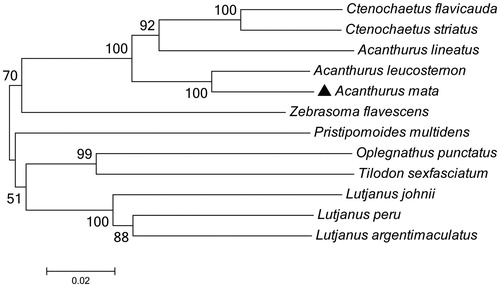Abstract
Acanthurus mata is one of most important genera of Acanthuridae. However, the systemically classification and taxonomic studies have so far been limited. In this study, we report the complete mitochondrial genome sequence of A. mata. The mitogenome has 15,102 base pairs (55.6% A + T content) and made up of total of 37 genes (13 protein-coding, 22 transfer RNAs and 2 ribosomal RNAs), and a putative control region. This study will provide useful genetic information for future phylogenetic and taxonomic classification of Acanthuridae.
Acanthurus mata belongs to the Family Acanthuridae and the Order Acanthuriformes, this species is distinguished by the following characters: body moderately deep and compressed, its depth 2.1–2.5 times in standard length or SL (smaller individuals are deeper-bodied); snout relatively short, 6–6.9 times in SL; eye 3.2–4.5 times in head length (at 12–28 cm SL) (Froese et al.).
There is no report of the complete genome of this species A. mata, which was developed in Shenzhen, Guangdong Province, Republic of China (N22°37′34″, E114°41′06″) in October 2019. Therefore, it is very important to characterize the complete mitogenome of this species, which can be utilized in research on taxonomic resolution, population genetic structure and phylogeography, and phylogenetic relationship. Total DNA was extracted from muscle following TIANamp Marine Animals DNA Kit (Tiangen, China), and NOVOPlasty software was used to assemble the mitogenomes, the mistake parameter was set by default (Dierckxsens et al. Citation2017). The samples were stored in –80 °C in Key Lab of South China Sea Fishery Resources Exploitation and Utilization, Ministry of Agriculture and Rural Affairs, South China Sea Fisheries Research Institute, Chinese Academy of Fishery Sciences, Guangzhou, China. Number is AM-1.
In this study, we obtained the complete mitochondrial genome of the A. mata. Its mitochondrial genome has been deposited in the GenBank under accession number MN872232. For a better understanding of genetic status and the evolutionary study, we focused on the genetic information contained in the complete mitochondrial genomes of the fish.
The complete mitogenome of the A. mata was 15,102 bp in length. The genomic organization was identical to those of typical vertebrate mitochondrial genomes, including two rRNA genes, 13 protein-coding genes, 22 tRNA genes, a light-strand replication origin (OL). The overall base composition was 29.3% of A, 26.3% of T, 28.6% of C, and 15.7% of G with a slight A + T bias (55.6%) like other vertebrate mitochondrial genomes. The features mentioned above were accordant with typical Acanthuridae fish mitogenome.
A. mata had one non-coding regions, the L-strand replication origin region (36 bp) locating between tRNA-Asn. Except for eight tRNA (tRNA-Ser, tRNA-Pro, tRNA-Glu, tRNA-Tyr, tRNA-Cys, tRNA-Asn, tRNA-Ala, and tRNA-Gln) and the ND6 gene were encoded on the L-strand, the others were encoded on the H-strand. This feature is similar to other fish mitochondrial genes. The complete mitogenome sequence had 16 s RNA (1,691 bp) and 12 s RNA (950 bp), which were located between tRNA-Phe and tRNA-Leu and separated by tRNA-Val gene. The location is same with most vertebrates that have high conservation.
To determine taxonomic status of A. mata, we reconstructed the phylogeny of this species with other natural populations based on the COI gene. The phylogenetic tree showed that the A. mata has the closer relationship with Acanthurus leucostemon (). The phylogeny was reconstructed based on the General Time Reversible + Invariant + gamma sites (GTR + I+ G) model of nucleotide substitution using Mega7 (Kumar et al. Citation2016). The complete mitochondrial genome sequence of the A. mata provided an important dataset for a better understanding of the mitogenomic diversities and evolution in fish as well as novel genetic markers for studying population genetics and species identification.
Figure 1. The phylogenetic relationship was estimated using the Maximum Likelihood method for the COI genes. Genbank accession Numbers: Acanthurus leucosternon (EU136032), Acanthurus lineatus (EU273284), Ctenochaetus striatus (KU244260), Zebrasoma flavescens (AP006032), Lutjanus peru (KR362299), Pristipomoides multidens (KF430626), Oplegnathus punctatus (AP011066), Tilodon sexfasciatum (AP014538), Lutjanus johnii (KJ643926), Lutjanus argentimaculatus (JN182927) and Acanthurus mata (MN872232). The numbers at the nodes are bootstrap percent probability values based on 1000 replications.

Disclosure statement
The authors alone are responsible for the content and writing of the paper. No potential conflict of interest was reported by the authors.
Additional information
Funding
References
- Dierckxsens N, Mardulyn P, Smits G. 2017. NOVOPlasty: de novo assembly of organelle genomes from whole genome data. Nucleic Acids Res. 45(4):e18.
- Froese, R. and Pauly D. (Eds). 2019. FishBase. World Wide Web electronic publication; [accessed 2020 Jan 22] www.fishbase.org.
- Kumar S, Stecher G, Tamura K. 2016. MEGA7: Molecular Evolutionary Genetics Analysis Version 7.0 for Bigger Datasets. Mol Biol Evol. 33(7):1870–1874.
